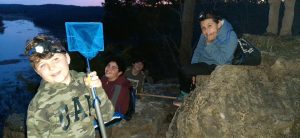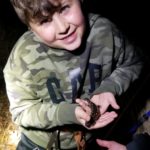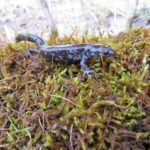When the ground thaws and the snows melt, amphibians stir from their hibernation. The ground saturates with moisture, and vernal pools form. “Vernal” meaning “occurring in spring,” and “pools” meaning “places where new life will soon be swimming.” It is in these vernal pools that amphibians—frogs, toads, or salamanders—congregate. They only have a limited amount of time to mate and lay their eggs. Those eggs hatch and the young metamorphose into adults, before the vernal pools dry up for the year.
These seasonal pools are in high demand by our amphibious friends because their impermanent nature means there are fewer predators in the water. This gives the amphibian young a better chance of survival into adulthood, something beneficial to an area’s entire ecosystem.
Amphibians are important
Amphibians are important to an ecosystem for many reasons. They eat many insects that are considered pests, thus keeping flies and mosquitoes out of our farms, gardens, and homes. This also makes them a crucial member of the food web, which maintains a delicate balance between all species in the community.
Additionally, amphibians have moist, permeable skin allowing them to breathe underwater. This permeability makes them highly susceptible to changes in their environment, and a great subject for monitoring. As ARMI(The Amphibian Research and Monitoring Initiative) explains, amphibians are “vulnerable to drought and toxic substances, so they are exceptional indicators of ecosystem health.”
By protecting and monitoring our amphibian friends, we can learn how well an entire ecosystem is functioning. This is what GreenVest is all about: using nature-based solutions (and indicators) to make the natural world a healthier place.
Night-time salamander viewing
Many amphibians travel under the cool and cover of darkness to find their breeding grounds, so observing them in often-hidden vernal pools can be very exciting. At GreenVest, we aim to preserve vernal pools on all of our wetland sites and their presence is an indicator of mitigation success. GreenVest has also successfully created and enhanced vernal pools on sites in an effort to increase amphibian breeding habitat.
Our enthusiasm for vernal pools and their amphibious inhabitants extends beyond the work week. One of GreenVest’s Vice Presidents, Brian Cramer, can often be found checking on vernal pools near his home in Sussex County, NJ. But he does not go it alone: he brings family and friends, passing on the love of nature and the importance of keeping an eye on the local ecosystem. These nighttime outings are great learning experiences: opening the next generation’s eyes to these wonderful creatures in their backyards.
Enjoy these pictures from some of our salamander-monitoring excursions. You will see the blue-spotted salamander and the (yellow) spotted salamander, New Jersey-classified endangered and special concern species, respectively. It goes without saying but is important to note: great care is taken as we locate and interact with salamanders. We take caution while handling them and always return them back to where they were found.






